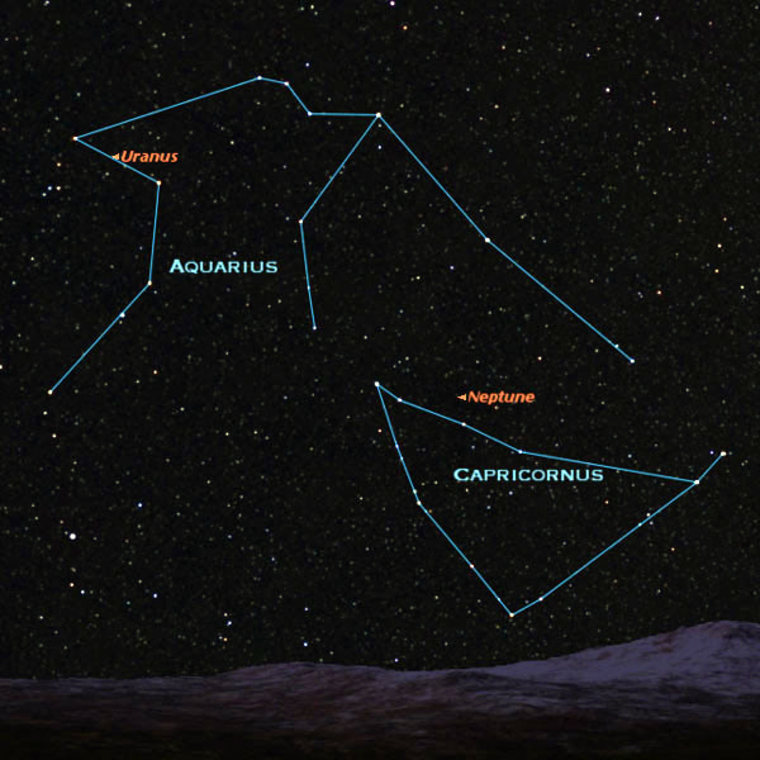Most people have seen the five brightest naked-eye planets, yet there is a sixth planet that can be spied without optical aid and another which can be picked up using just a good pair of binoculars.
You'll have to know exactly where to look for them, though.
Fortunately, both are currently well placed for viewing in our evening sky and with the bright moon out of the way this week, it will be a good time to search for them.
Uranus
Barely visible to the unaided eye on very dark, clear nights, the planet Uranus is now visible during the evening hours among the stars of Aquarius, the Water Carrier. It is best to study a sky map first, and then scan that region with binoculars. Using a magnification of 150-power with a telescope of at least three-inch aperture, you should be able to resolve it into a tiny, pale-green featureless disk.
Uranus, which lies at a mean distance of 1.8 billion miles from the sun, has a diameter of about 31,800 miles. At last count, Uranus has 27 moons, all in orbits lying in the planet's equator in which there is also a complex of nine narrow, nearly opaque rings, which were discovered in 1978. Uranus has a rocky core, surrounded by a liquid mantle of water, methane, and ammonia, encased in an atmosphere of hydrogen and helium.
A bizarre feature of the planet is how far Uranus is tipped. Its north pole lies 98 degrees from a perpendicular to its orbit plane. Thus, its seasons are extreme: when the sun rises at its north pole, it stays up for 42 Earth-years; then it sets and the north pole is in darkness for 42 Earth-years.
Sir William Herschel discovered Uranus on March 13, 1781, noting that it was moving slowly through the constellation Gemini. Initially, however, Herschel thought he had discovered a new comet.
Neptune
Neptune, on the other hand, is much too faint to be viewed with the unaided eye, lying at a mean distance from the sun of 2.8 billion miles. It is slightly smaller than Uranus, with a diameter of 30,800 miles.
Neptune is about seven times dimmer than Uranus, but if you have access to a dark, clear sky and carefully examine our map, you should have no trouble in finding it with a good pair of binoculars. Neptune can be found among the stars of Capricornus, the Sea Goat. With a telescope, trying to resolve Neptune into a disk will be more difficult than it is with Uranus. You're going to need at least a four-inch telescope with a magnification of no less than 200-power, just to turn Neptune into a tiny blue dot of light.
Voyager 2 passed Neptune in 1989 and showed it to possess a deep-blue atmosphere, with rapidly moving wisps of white clouds as well as a Great Dark Spot, rather similar in nature to Jupiter's famous Great Red Spot.
Voyager 2 also revealed the existence of at least three rings around Neptune, composed of very fine particles.
Neptune has 13 moons, one of which, Triton, has a tenuous atmosphere of nitrogen and at nearly 1,700 miles in diameter is larger than Pluto.
Discovery link
Neptune's discovery came about from long-term observations of Uranus. It seemed to astronomers that some unknown body was somehow perturbing Uranus' orbit.
In 1846, two astronomers, Urbain J.J. Leverrier (1811-1877) of France and John Couch Adams (1819-1892) of England, were independently working on this problem. Neither knew what the other was doing, but ultimately, both men had figured out the probable path of the supposed object that was disturbing the orbit of Uranus. Both believed that the unseen body was then in the constellation of Aquarius. Adams was a student at Cambridge University, England, and he sent his results to Sir George Airy (1801-1892), the Astronomer Royal, with specific instructions of where to look for it.
For some unknown reason Airy delayed a year before starting the search. In the meantime, Leverrier wrote to the Berlin Observatory requesting that they search in the place his observations directed. Johann Galle and Heinrich d'Arrest at Berlin did exactly as instructed, and found the new planet in less than an hour.
